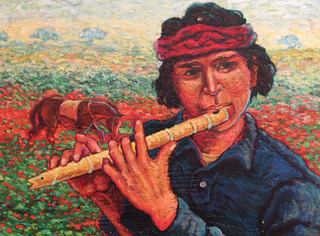The Austen D. Warburton Collection of Native American Art and Artifacts has remained within the confines of the Triton Museum of Art since 1989 — but that could soon change.
At a recent City Council meeting, the museum discussed its plans to make the collection more accessible to the public.
“For years, we had it on semi-permanent display, but then after a while, we had to change it up and cycle some things out,” said Preston Metcalf, Deputy Director of the Triton. “Our goal now is to see how we can partner with different organizations to loan them parts of the collection so people can see it.”
The collection, donated to the city by Austin D. Warburton, hasn’t been shown in depth to the public for about 15 years. Small offerings from it have been on display every now and then, but it’s only available to scholars at this time.
Warburton, an attorney and early board member of the Triton, collected thousands of pieces of Native American art and artifacts throughout his life. Many of them, including intricately woven baskets, pottery and blankets, came from tribes and regions throughout California, and some can be dated back to over 1,500 years ago.
“A lot of people weren’t aware that he was a very noted scholar on Native American art and artifacts and history,” Metcalf said. “At one point, he was kind of the definition of the amateur archaeologist, and he took it very seriously. It was a hobby that turned into a lifelong passion.”
Warburton became an advocate for many of the local and regional Native American groups. As an attorney, he would do a lot of pro-bono work on their behalf. He also met many of the artists and developed friendships with them.
Before Warburton donated his collection, the Triton Museum of Art, founded by W. Robert Morgan in 1965, was originally located in San Jose. After two years, Morgan lost the lease and moved the museum to the City of Santa Clara. The non-profit organization would build the museum, and then after 25 years, ownership of the museum would turn over to the city, which it can lease back.
After the city gained ownership, Morgan was worried the city might change its mind and utilize the museum’s facilities in another way. So Morgan and other board members arranged for 47 major California impressionist paintings by Theodore Wares to be donated to the city.
“So it’s their collection — on the condition that the Triton Museum of Art would care for it, maintain it and preserve it for perpetuity,” Metcalf said. “Therefore, the city has a world-class collection and the Triton Museum cares for it, so we’re reliant upon one another. The city continues to give us good civic support and take care of the facilities, and we take care of the collection.”
To keep the symbiotic relationship between the museum and the city going, Warburton donated his entire collection of Native American art and artifacts to Santa Clara.
The idea to make the collection more accessible to the public came as a result of the restoration of the Theodore Wores paintings. They are now on display, but the museum hopes to tour them at different museums throughout the state instead of putting them back on the shelves after the exhibition is over.
“So thinking of that, we’ve actually started thinking of, ‘Well, what are we doing with the Austen Warburton collection?’” Metcalf said. “We don’t have any immediate plans to show it because we have shown it so much, but we want to make it available to more people that may not be crossing our threshold.”
One place the museum is considering displaying the collection is the library. The idea was brought up by Council Member Debi Davis at the Santa Clara City Council meeting. Metcalf said it’s a great idea since the library has cases to house the pieces, as well as academic works to back them up.
Metcalf said he hopes the collection will leave people with more questions than they came with.
“We can give them little brief answers, like with the text below that accompanies a piece,” he said. “But if they leave with an interest and a desire to learn more, then I think we did our job.”






